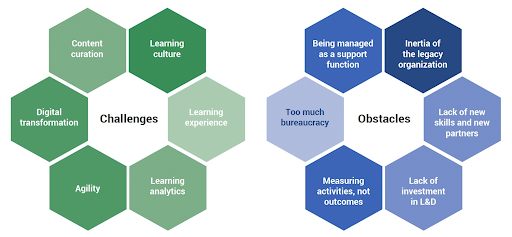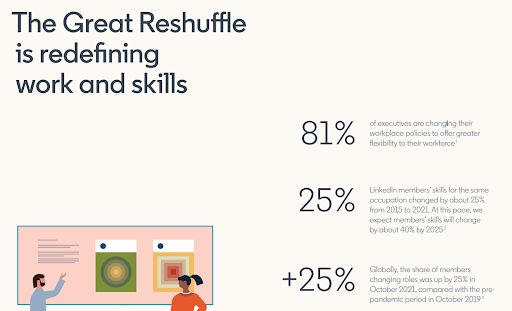The world of corporate learning and development is constantly evolving, and companies of all sizes are beginning to recognize the value of having a learning leader or manager on staff. But who, exactly, is the learning leader, and what do they do?
A learning leader, or chief learning officer (CLO), is an individual responsible for leading and managing the learning and development efforts of a company.
They are charged with developing strategies that facilitate employee learning and development, as well as identifying and deploying the best available learning and development tools and techniques.
After all, a continuous learning process in a business always starts with L&D.
The learning leader works closely with company executives to ensure that the learning strategy is aligned with the company’s overall goals and objectives.
In this article, we will look at the role the learning leader has in today’s organization, the role it can AND should play in the near future, and why it’s fundamental to transform the entire learning and development function.

So, Which Companies Really Need A Learning Leader?
The truth is that any company that wants to be successful in today’s competitive environment needs to invest in learning and development.
So, that translates to “EVERY company.”
Whether you’re a large corporation or a small business, having a learning leader on staff helps ensure that your employees are well-trained and have the skills they need to stay ahead.
According to a report, over half of the leaders in 2022 provided their employees with upskilling (59%) and reskilling (55%) training.
In today’s business world, learning leaders are increasingly in demand.
Companies of all sizes are recognizing the value of having a learning leader on staff and are investing in their own learning and development departments.
Creating A Learning-Focused Culture
Great leadership of the learning function can transform a diffuse work culture into a learning culture.
When the stars align, it can even turn a business into a true learning organization.
This is an exciting and potentially rewarding journey for any organization, but also a challenging one.

In order to create an effective learning culture, organizations must recognize the importance of some factors that contribute to strong L&D.
The learning function starts with empowering the people in the organization to take charge of their own learning.
Leaders should strive to create an environment that actively encourages learning and makes it easy for employees to access the resources they need to develop their skills.
Next, the organization should focus on creating an environment that is conducive to learning.
This means creating an environment that is open to new ideas, encourages experimentation, and rewards those who take risks.
The organization (with the help of the L&D leader) should also encourage communication between employees and ensure that learning is seen as an integral part of the organization’s culture.
Finally, must create a culture where learning is not something that is done once and then forgotten but rather something that is continuously nurtured and developed.
A culture of learning should be built on the foundation of experimentation, failure, and continuous improvement.
Why Is It Important To Transform The Learning-And-Development Function?
First and foremost, companies need to keep up with the latest technology and industry trends.
A learning-and-development function that is not up to date with the latest innovations and advances in technology can no longer provide employees with the skills they need to stay competitive.
In 2023, L&D has a strategic role in this new business landscape, and one thing they can do to help their organizations is to keep learning themselves.
Second, a transformation of the learning-and-development function allows for more personalization of the learning experience.
By understanding each individual’s needs and goals, companies can tailor training programs and take strategic initiatives that support capability building.
So, in 2022, 81% of executives changed their workplace policies to offer greater flexibility to their workforce.

That’s how as an L&D leader, you can ensure that employees are able to learn the skills they need in the most effective way.
Finally, when the learning-and-development function is transformed, companies can create a learning culture where collaboration, creative problem-solving, and experimentation are encouraged.
This helps foster innovation, allowing employees to develop new skills that can be applied to their work.
By leveraging technology, personalizing the learning experience, and encouraging collaboration and innovation, companies can create a learning culture that will help them stay ahead of the competition.
Cumbersome Legacy Platforms And Systems
As mentioned several times already, as Learning and Development (L&D) leaders, your job is to ensure that our organization’s learning and development efforts are up-to-date, effective, and efficient.
You strive to keep our organization’s learning and development initiatives aligned with the latest trends and technology, as well as changing business needs.
Yet, many are reluctant to change systems that have worked well in the past.
After all, it’s simply too much work, and no one is on board.
However, the reality is that many of these systems are outdated and no longer support next-generation learning.
Furthermore, they can be cumbersome and slow down the response rate to changing business needs.
So, it is also important to evaluate existing systems and platforms periodically to ensure that they are still relevant and effective.
If you find that a particular system or platform is no longer meeting your organization’s needs, it may be time to consider a change.
This way, you can ensure that your organization’s learning and development efforts are up-to-date and effective.
This takes us to…
The (Near) Future Of Learning Leaders
In today’s world of rapid technological advancements, the role of the Learning & Development (L&D) leader has become increasingly important.
As companies strive to stay competitive and agile, they are increasingly turning to L&D to meet their changing learning needs.
However, many L&D functions today are more stable than necessary, to the point of rigidity.
Program delivery, content management, and digital-platform support often work in different departments that have their own key performance indicators, which are not necessarily linked to overall business goals or corporate learning goals.
This lack of dynamism and flexibility can lead to a “one-size-fits-all” approach that fails to meet the changing needs of the organization. It can also create an environment that is too rigid, leading to stagnation and a lack of innovation.
The future of L&D is one that must balance stability and dynamism in order to ensure that the organization remains agile and responsive.

Creating An Environment Where Dynamism And Stability Are Both Present.
It is essential to create a stable backbone that allows the learning function to keep up with an organization’s learning needs while also introducing a level of dynamism that keeps the solutions fresh and relevant.
This requires the L&D leader to bring together the different components of the learning function, from program-delivery and digital-platform support to the implementation of effective performance management initiatives.
1.The first step in achieving this balance between stability and dynamism is to ensure that all the components of learning and development are aligned with the overall business goals and the corporate learning goals.
This alignment needs to be achieved both on a strategic and operational level.
On the strategic level, leaders should consider how their learning solutions can help the business achieve its goals and objectives.
On the operational level, they should look at how the solutions can be implemented and monitored in order to ensure their effectiveness.
- The second step is to ensure that all the different components of the L&D function are integrated and working together.
This means that program-delivery and digital-platform support need to be working in tandem, with the same key performance indicators and metrics linked to the overall business objectives.
It also means that performance management initiatives need to be implemented across all the different components of the function in order to ensure that everyone is working toward the same goals and objectives.
Ultimately this means getting the C-suite executives on board with everything regarding the learning program and its objectives. That’s how one can really transform an entire organization.
- Finally, the L&D leader must ensure that the solutions they provide are up-to-date and relevant. This means that the solutions need to be regularly reviewed and updated to ensure that they are able to keep up with the ever-changing business landscape.
To Wrap Things Up
The future role of the L&D leader is one that requires a great deal of skill, knowledge, and experience.
It requires the L&D leader to be able to strike the right balance between stability and dynamism and to create the right learning solutions that will help the business achieve its goals.
By ensuring that all the components of the L&D function are working together, that the solutions are up-to-date and relevant, and that the performance management initiatives are in place, the L&D leader can ensure that the function is able to keep up with an organization’s learning needs.
In the end, the L&D leader must create an environment of trust and collaboration. They must be able to bring together different stakeholders and get everyone on the same page.
This includes having an open and direct dialogue with business leaders and employees.
This will help ensure that the L&D team is meeting the organization’s learning needs and is working in unison with other departments.

